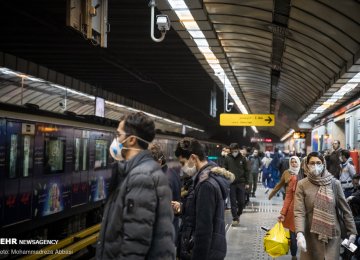As an increasing population use public transportation in the Iranian capital city, Tehran, adhering to social distancing will turn into a farfetched goal.
Yousef Hojjat, the head of Transportation and Traffic Organization of Tehran Municipality, told Tasnim News Agency that since April 11, the so-called low-risk businesses have resumed activities. A large number of people who do not own a private car inevitably take a bus or taxi, or use subway to get to work.
Hojjat says the number of people using Tehran’s subway everyday reached 350,000 in the past week.
“Keeping a reasonable distance between passengers becomes almost impossible if the number goes higher, say 450,000,” he said.
Before COVID-19, Tehran Metro used to carry up to 3 million passengers per day. Health experts warn that the use of public transport can increase the coronavirus infection risk.
“The virus is still spreading and infecting people in the city and the situation has not normalized. The resumption of social activities can make it tough to handle mortalities related to the disease,” he added.
Similarly, Mohsen Hashemi the chief of Tehran City Council, had said early this week that social distancing is almost impossible in a crowded city like Tehran, unless more buses and taxis are added to the public transportation fleet.
Social distancing is considered the most effective way of curbing the rapid spread of the killer coronavirus disease, COVID-19.
Using public transport services is considered hazardous for drivers and passengers.
Hashemi underlined the warnings of Health Ministry and professionals over the risk of contamination in the use of public means of transportation and said, “Public vehicles are more polluted compared to universities and schools. So extra care should be taken by citizens using them.”
Since April 11, low-risk businesses have resumed activities and a large number of people without a private car will inevitably take a bus, taxi or subway to get to work
Adding to his concerns, Hashemi said the ventilation system of subway trains is concentrated, meaning that the air in wagons is constantly circulating and combining with air outside the train.
“This means one infected person in a train car can most possibly pollute the air in all cars. There is a strong possibility of the second wave of coronavirus pandemic starting in the city, if nothing is done about the issue,” he added.
Hashemi suggested that boosting the production of vehicles can help increase the number of buses and taxis active in the transportation system.
“Only then people can partially adhere to social distancing,” he added.
Pointing to the fact that the budget allocated to the supply of buses and taxis has never been adequate in the past several years, Hashemi said the annoying shortage of vehicles is absolutely tangible in the city. He called on the government and banks to help resolve the issue.
According to TM, the number of buses operating in Tehran hardly reaches 6,000 which, according to experts, is half the number required for offering acceptable transportation services.
Experts say the average age of the fleet is over 11 years, such that 50% of the buses plying the streets of Tehran are dilapidated and fit for the scrapyard.
Besides, 1,000 subway cars are currently operating in the capital's urban subway system, 30% of which need to be upgraded.
The capital's subway stretches over 220 kilometers and comprises seven lines (1 to 7) with nearly 120 stations. Lines 6 and 7 are yet to become fully operational.
On a normal day, over four million people use the subway for commute. TM expects the number to surge by 25% after subway lines 6 and 7 are up and running.
Measures and Challenges
To make the best out of the least, urban officials have marked subway train seats to help passengers maintain a safe distance. The train headway has also shrunk by one to three minutes depending on the line, to curb the crowd.
However, the efficiency of signs declines when the train is packed with passengers.
Moreover, cabs in Tehran have been ordered to accept only three passengers (instead of four) per trip, with no fare increase.
Alireza Qannadan, the head of Tehran Taxi Organization, says although a large number of cabbies have so far adhered to the rule, the policy has a negative effect on the livelihood and income of drivers.
“We cannot implement a national scheme by discounting people’s daily income. Of course, the government should pay financial allowance to drivers for compensating their losses,” he said.
“This can also motivate cabbies to continue their efforts and sincerely adhere to the rules.”
Iran reported the virus outbreak in mid-February, which has so far taken the lives of 4,474 people out of a total of 71,686 infected people.
According to Iran’s Health Ministry, 43,894 patients have so far recovered from the disease.
In another effort to flatten the coronavirus curve in the capital city and motivate people to keep away from the hazardous public vehicles, the traffic restriction rule in the city called “Traffic Scheme” has been waived until further notice.
The scheme is usually enforced in a 3,000-hectare area limited by Motahari Street in the north, Shariati Street in east, Kargar (west) and Shoosh (south) where cars, except public transportation vehicles, are barred from entering the area between 7 a.m. and 6 p.m. Entering the zone costs up to 517,000 rials ($3.2) for private vehicles.
Brigadier General Mohammad Reza Mehmandar, Tehran's Traffic Police chief, said the scheme will not run till April 24.
“The extension of waiver or resumption of the scheme depends on the decision of the nation coronavirus taskforce,” he added.






Add new comment
Read our comment policy before posting your viewpoints